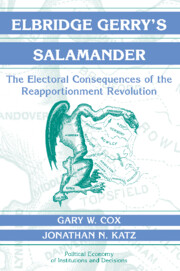Book contents
- Frontmatter
- Contents
- List of Tables and Figures
- Preface
- Part I Introduction
- Part II Democrats and Republicans
- Part III Incumbents and Challengers
- 8 The Growth of the Incumbency Advantage
- 9 Candidate Entry Decisions and the Incumbency Advantage
- 10 Redistricting and Electoral Coordination
- 11 Redistricting, the Probability of Securing a Majority, and Entry
- 12 Reassessing the Incumbency Advantage
- Part IV Conclusion
- References
- Author Index
- Subject Index
- Titles in the series
8 - The Growth of the Incumbency Advantage
Published online by Cambridge University Press: 10 November 2009
- Frontmatter
- Contents
- List of Tables and Figures
- Preface
- Part I Introduction
- Part II Democrats and Republicans
- Part III Incumbents and Challengers
- 8 The Growth of the Incumbency Advantage
- 9 Candidate Entry Decisions and the Incumbency Advantage
- 10 Redistricting and Electoral Coordination
- 11 Redistricting, the Probability of Securing a Majority, and Entry
- 12 Reassessing the Incumbency Advantage
- Part IV Conclusion
- References
- Author Index
- Subject Index
- Titles in the series
Summary
In the previous part of the book, we focused on why pro-Republican bias in nonsouthern congressional elections abruptly disappeared in the 1960s. In this part of the book, we turn to an even more famous pair of puzzles in the literature: why incumbents' margins of victory increased abruptly in 1966, and why the so-called incumbency advantage increased – again abruptly, again in 1966.
In this chapter, we set the stage for the analyses to come in three ways. First, we explain the two incumbency-related puzzles in more detail. Second, we articulate the principles behind our investigation in this part of the book, sketching the connections between incumbents' electoral fortunes and the reapportionment revolution. Third, we show that there are previously unnoticed partisan differences associated with each puzzle: the Republican marginals vanished more than did the Democratic marginals, and the Republican incumbency advantage increased more than did the Democratic incumbency advantage. We thus add two more items to the list of explananda that a complete model of postwar congressional elections must address.
incumbents' margins and advantages
The Vanishing Marginals
A marginal district is one that is not firmly held by either major party. Operationally, marginal districts are usually defined as those in which the winner garners 50–55% (or sometimes 50–60%) of the two-party vote, the idea being that such a slim margin of victory might well be overcome in the next election.
In a famous article, Mayhew (1974) showed that marginal districts (defined by the 50–55% criterion) were fairly common in early postwar elections but rather abruptly less common after 1966. Moreover, open seats showed no trend in marginality; only districts defended by incumbents became less often marginal.
- Type
- Chapter
- Information
- Elbridge Gerry's SalamanderThe Electoral Consequences of the Reapportionment Revolution, pp. 127 - 139Publisher: Cambridge University PressPrint publication year: 2002
- 1
- Cited by



